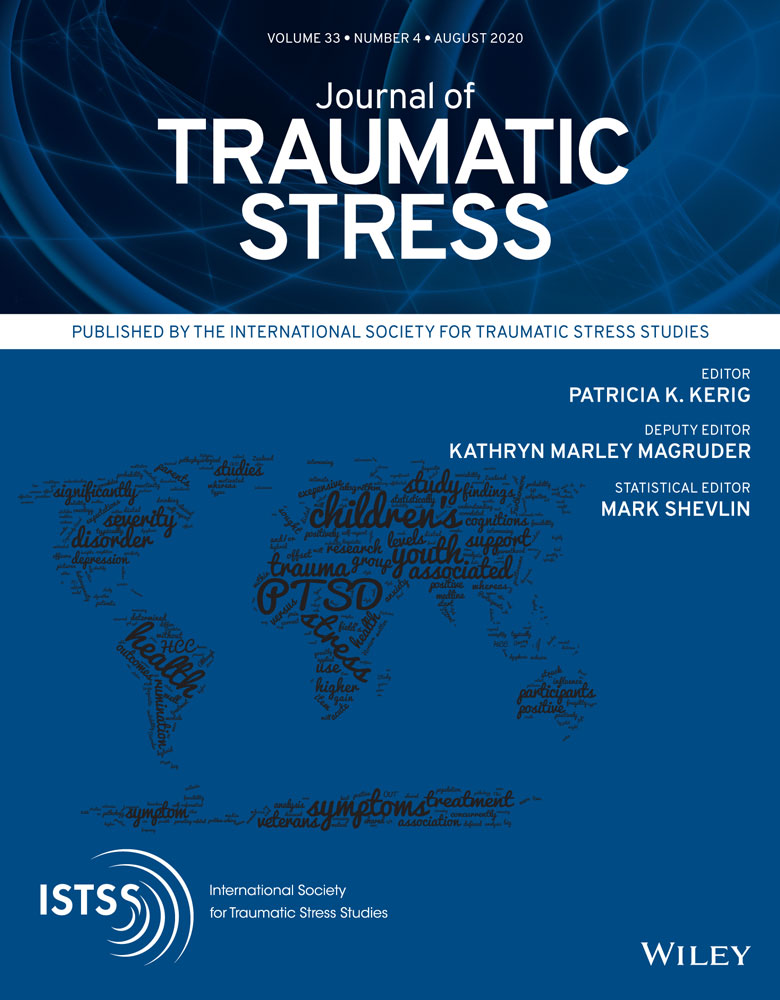Residual Symptoms of Posttraumatic Stress Disorder and Alcohol Use Disorder Following Integrated Exposure Treatment Versus Coping Skills Treatment
This material is the result of work supported with resources and the use of facilities at the National Center for PTSD, the VA San Diego Healthcare System, and the Center of Excellence for Stress and Mental Health. Funding for this work was made possible by a Veterans Affairs Clinical Science Research and Development Merit Grant (1I01CX000756; PI: Sonya Norman; ClinicalTrials.gov identifier: NCT01601067).
Abstract
enAlthough some studies have demonstrated residual symptoms in patients who have participated in posttraumatic stress disorder (PTSD) treatment, no studies to date have assessed residual PTSD symptoms following treatment for comorbid alcohol use disorder (AUD) and PTSD (PTSD/AUD). We examined residual symptoms of PTSD and AUD in 73 veterans with PTSD/AUD who completed a posttreatment assessment after being randomized to receive either Concurrent Treatment of PTSD and Substance Use Disorders Using Prolonged Exposure (COPE) or Seeking Safety (SS). We used logistic regression to identify differences (a) in residual PTSD and AUD symptoms among participants randomized to COPE versus SS and (b) among those with versus without a posttreatment PTSD/AUD diagnosis within both treatment conditions. Participants randomized to SS were more likely to report persistent avoidance, inability to experience positive emotions, hypervigilance, difficulty concentrating, and difficulty sleeping, ORs = 3.74–6.21. There were no differences between COPE and SS regarding the likelihood of persistent AUD symptoms. Participants without a posttreatment PTSD diagnosis had lower conditional probabilities of most symptoms, although exaggerated startle, OR = 0.71, and irritability/aggression, OR = 0.58, were most likely to persist. Participants without a posttreatment AUD diagnosis had lower conditional probabilities of most symptoms, although withdrawal, OR = 0.21; unsuccessful quit attempts, OR = 0.04; and higher intake, OR = 0.01, were most likely to persist. Findings indicate hyperarousal may warrant additional intervention following PTSD treatment. Residual AUD symptoms may relate to the enduring nature of some AUD symptoms rather than a lack of treatment efficacy.
Resumen
esSpanish Abstracts by Asociación Chilena de Estrés Traumático (ACET)
Síntomas Residuales de TEPT y AUD después del Tratamiento de Exposición Integrado versus el Tratamiento de Habilidades de Afrontamiento
SÍNTOMAS RESIDUALES DE TEPT Y TRASTORNO DE USO DE ALCOHOL
Aunque algunos estudios han demostrado síntomas residuales en pacientes que han participado en el tratamiento del trastorno de estrés postraumático (TEPT), hasta la fecha ningún estudio ha evaluado los síntomas residuales del TEPT después del tratamiento del trastorno por consumo de alcohol (TUA) y el trastorno de estrés postraumático (TEPT / TUA) concomitantes. Examinamos los síntomas residuales de TEPT y TUA en 73 veteranos con TEPT / TUA que completaron una evaluación posterior al tratamiento después de haber sido asignados al azar para recibir tratamiento concurrente de TEPT y trastornos por uso de sustancias con exposición prolongada (COPE en su sigla en inglés) o buscando seguridad (BS). Usamos regresión logística para identificar diferencias (a) en los síntomas residuales de TEPT y TUA entre los participantes asignados al azar a COPE versus BS y (b) entre aquellos con versus sin un diagnóstico de TEPT / TUA postratamiento dentro de ambas condiciones de tratamiento. Los participantes asignados al azar a BS tenían más probabilidades de informar de evitación persistente, incapacidad para experimentar emociones positivas, hipervigilancia, dificultad para concentrarse y dificultad para dormir, OR = 3.74–6,21. No hubo diferencias entre COPE y BS con respecto a la probabilidad de síntomas persistentes de TUA. Los participantes sin un diagnóstico de TEPT postratamiento tenían probabilidades condicionales más bajas en la mayoría de los síntomas, aunque era más probable que persistiera el sobresalto exagerado, OR = 0.71, y la irritabilidad / agresión, OR = 0.58. Los participantes sin un diagnóstico de TUA postratamiento tenían probabilidades condicionales más bajas en la mayoría de los síntomas, aunque abstinencia, OR = 0.21; intentos fallidos de dejar de fumar, OR = 0.04; y una ingesta más alta, OR = 0.01, era más probable que persistiera. Los resultados indican que la hiperactivación puede justificar una intervención adicional después del tratamiento del TEPT. Los síntomas del TUA residual pueden estar relacionados con la naturaleza duradera de algunos síntomas del TUA más que con la falta de eficacia del tratamiento.
抽象
zhTraditional and Simplified Chinese Abstracts by the Asian Society for Traumatic Stress Studies (AsianSTSS)
簡體及繁體中文撮要由亞洲創傷心理研究學會翻譯
Residual Symptoms of PTSD and AUD Following Integrated Exposure Treatment versus Coping Skills Treatment
Traditional Chinese
標題: 完成綜合暴露療法與適應技巧療法的患者, 其殘餘的PTSD與AUD症狀比較
撮要: 雖然過往研究發現, 有些患者接受創傷後壓力症(PTSD)治療後有殘餘症狀, 但目前並未有研究評估患者接受酒精使用疾患(AUD)與PTSD共病(PTSD/AUD)治療後的殘餘PTSD症狀。我們檢視73名患PTSD/AUD的退役軍人其殘餘的PTSD與AUD症狀。樣本被隨機分派到兩組:一組接受PTSD及AUD的延長暴露同時治療法(COPE), 另一組接受尋求安全治療(SS)。樣本在完成治療後接受評估。我們採用邏輯迴歸法, 比較以下方面:(a) 兩組樣本的殘餘PTSD與AUD症狀;(b) 兩組完成治療後有或無確診患PTSD/AUD的樣本。被隨機分配到接受SS的樣本, 較大機會有持續性迴避、感受正向情緒的困難、過度警覺、專注困難、睡眠困難)ORs = 3.74–6.21(。在有持續AUD症狀的機率方面, COPE和SS兩組之間並無差異。完成治療後並無確診患PTSD的樣本, 在大多數症狀方面, 患有的條件機率都較低, 但過度的驚嚇反應)OR = 0.71(及易怒/攻擊性)OR = 0.58(最大機會維持。完成治療後並無確診患AUD的樣本, 在大多數症狀方面, 患有的條件機率都較低, 但戒斷症狀)OR = 0.21(、不成功的戒癮嘗試)OR = 0.04(及較大涉取量)OR = 0.01(最大機會維持。結果反映, 我們可能有需要在患者完成PTSD治療後, 針對過激反應提供額外干預。殘餘的AUD症狀可能跟有些AUD症狀其持久的本質有關, 而非療法功效的問題。
Simplified Chinese
标题: 完成综合暴露疗法与适应技巧疗法的患者, 其残余的PTSD与AUD症状比较
撮要: 虽然过往研究发现, 有些患者接受创伤后压力症(PTSD)治疗后有残余症状, 但目前并未有研究评估患者接受酒精使用疾患(AUD)与PTSD共病(PTSD/AUD)治疗后的残余PTSD症状。我们检视73名患PTSD/AUD的退役军人其残余的PTSD与AUD症状。样本被随机分派到两组:一组接受PTSD及AUD的延长暴露同时治疗法(COPE), 另一组接受寻求安全治疗(SS)。样本在完成治疗后接受评估。我们采用逻辑回归法, 比较以下方面:(a) 两组样本的残余PTSD与AUD症状;(b) 两组完成治疗后有或无确诊患PTSD/AUD的样本。被随机分配到接受SS的样本, 较大机会有持续性回避、感受正向情绪的困难、过度警觉、专注困难、睡眠困难)ORs = 3.74–6.21(。在有持续AUD症状的机率方面, COPE和SS两组之间并无差异。完成治疗后并无确诊患PTSD的样本, 在大多数症状方面, 患有的条件机率都较低, 但过度的惊吓反应)OR = 0.71(及易怒/攻击性)OR = 0.58(最大机会维持。完成治疗后并无确诊患AUD的样本, 在大多数症状方面, 患有的条件机率都较低, 但戒断症状)OR = 0.21(、不成功的戒瘾尝试)OR = 0.04(及较大涉取量)OR = 0.01(最大机会维持。结果反映, 我们可能有需要在患者完成PTSD治疗后, 针对过激反应提供额外干预。残余的AUD症状可能跟有些AUD症状其持久的本质有关, 而非疗法功效的问题。




